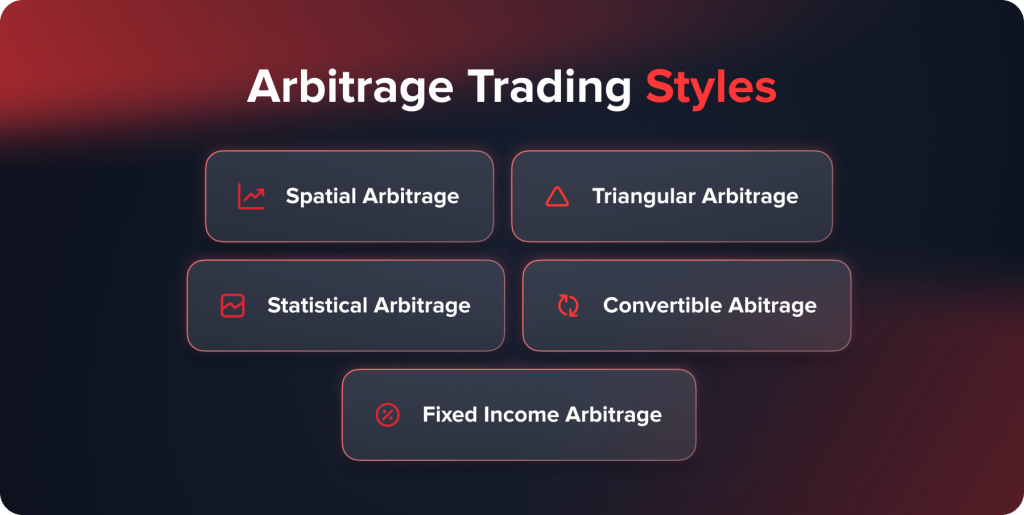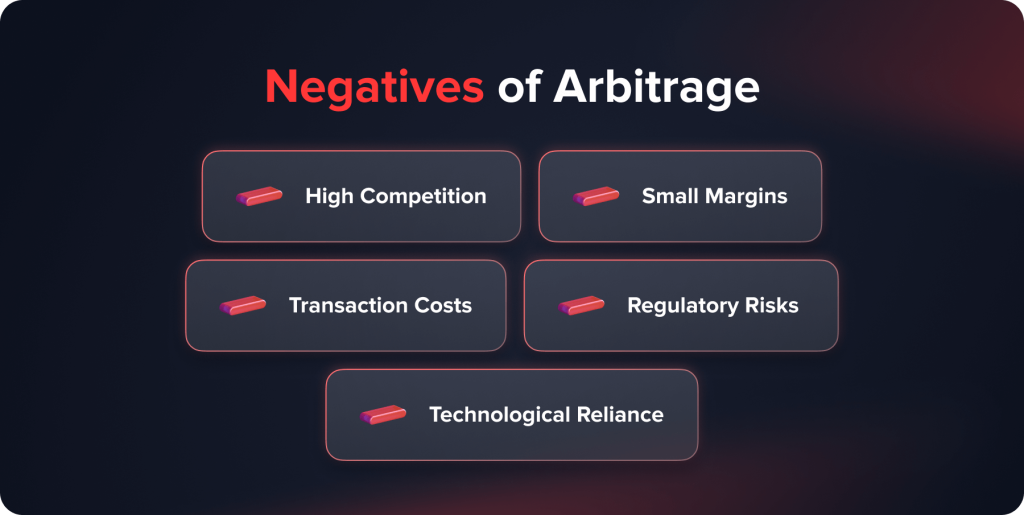
Arbitrage Trading: What is and How it Works
Contents
Arbitrage trading — using pricing variations between many markets or asset classes — is a well-known tactic in the financial sector. This approach’s fundamental concept is to use price variations by purchasing low in one market and selling high in another. This in-depth article will teach you the nuances of arbitrage trading, its advantages and disadvantages, the state of regulations, and broker perspective.
How Does Arbitrage Work?
Arbitrage trading is meant to benefit from price fluctuations in assets. Arbitrage allows a trader to earn by buying and selling an asset concurrently on several markets with varying pricing. Though this strategy seems simple, it requires thorough market knowledge, experience, and the tools required to seize possibilities.
Arbitrage trading mostly profits on market differences that could arise from variables such changes in market liquidity, mismatches in supply and demand, or gaps in updating prices across platforms. Successful arbitrage trading depends on speed, accuracy, and rapid transaction capacity; these differences usually have little bearing on one other.
You may also like

Various Arbitrage Trading Styles
Although it may be used in methods spanning markets and asset kinds, arbitrage trading is not a one-size fits all approach. These are some typical variances below.

- Spatial Arbitrage is the arrangement wherein the same item is bought and sold at several geographical sites. The example of a stock listed on two exchanges mentioned earlier falls into this category. Geographical arbitrage can also entail any asset exchanged between markets, currencies, or commodities.
- Triangular Arbitrage takes use of variations in three currencies’ exchange rates. If the rates change between USD, EUR, and GBP, to make a profit an arbitrageur would convert USD to EUR, EUR to GBP and then GBP back to USD.
- Statistical arbitrage uses statistical analysis to identify opportunities for trade. It typically entails the trading of pairings of stocks or assets that exhibit a correlation. When their prices diverge, the trader wagers that they will reunite by purchasing the undervalued asset and selling the overvalued one.
- Convertible arbitrage is purchasing bonds or preferred stock and shorting the underlying stock. Particularly in cases of market conditions making conversion profitable, the goal is to profit from the variations in pricing between the security and its underlying equity.
- Fixed Income arbitrage is an approach implemented in bond markets, where speculators capitalize on price disparities between fixed income investments. As an illustration, they may invest in government bonds and their derivatives or trade bonds of varying maturities from the same issuer to capitalize on yield fluctuations.
Risks and Considerations
Arbitrage trading is not without risks, despite the potential for profit. Execution is the primary risk factor, as traders may face difficulties in conducting transactions, which could lead to losses. Another consideration is market risk as asset values could change negatively between acquisition and selling, therefore lowering profits. Furthermore affecting the profitability of arbitrage activities are transaction costs like taxes and broker fees.
Liquidity is another aspect to bear in mind. In illiquid markets, buying or selling assets in required quantities without affecting prices could prove difficult, possibly negating arbitrage opportunities. Additionally with the increasing efficiency of markets, the frequency and profitability of arbitrage opportunities may diminish over time presenting a challenge for those relying on this strategy.
Is Arbitrage Trading Illegal?
In its basic and fundamental form, arbitrage trading is considered legal. It is recognized as a legitimate trading method across most jurisdictions.
Arbitrage serves a purpose in markets by minimizing price disparities and enhancing market efficiency. This practice is not only lawful but beneficial as it works towards aligning prices with their true value promoting fairness across different trading platforms.
Many countries allow arbitrage trading, within the boundaries of regulations of course, as it helps rectify pricing discrepancies and enhances market liquidity. In established markets such as the US, UK and EU arbitrage trading is considered a legal practice in market operations. Traders engaging in arbitrage activities are generally viewed as operating within limits long as they comply with regulatory requirements.
The legality of arbitrage can vary depending on the type of arbitrage strategy employed, how it is executed. Simple forms of arbitrage such as triangular arbitrage are widely accepted globally and deemed lawful.
However there are instances where arbitrage trading may cross boundaries. For instance insider trading and information based arbitrage involve using non-public information to conduct trades for personal gain. Such practices are illegal in most parts of the world with regulatory bodies implementing stringent laws to combat insider trading. Additionally there are methods of arbitration, like market manipulation and front running.
Can You Make a Living Off of Arbitrage?
Certainly engaging in arbitrage can be a means of earning a livelihood. However it necessitates expertise, experience and substantial capital investment. Arbitrage trading entails identifying and leveraging price differentials across markets or assets. While the idea may seem straightforward, at glance consistently making a profit through arbitrage requires more than a basic grasp of market dynamics. To succeed in arbitrage trading individuals need an understanding and expertise in the markets they operate in. This entails being well versed in market trends, liquidity levels and the optimal timing for transactions. Individuals who excel in arbitrage frequently have spent years refining their abilities and developing the capacity to identify opportunities that others may overlook.
What Are the Negatives of Arbitrage?
Despite its potential for gains, arbitrage trading poses notable challenges that can complicate it as a strategy. These challenges arise from the nature of the market, the necessity for cutting edge technology and the presence of unforeseen risks.

High Competition
One of the downsides of engaging in arbitrage trading is facing competition. The concept of arbitrage is widely recognized within financial markets, attracting traders ranging from major institutions to hedge funds and proprietary trading firms—all vying for identical opportunities.
Large corporations in this field have enormous resources at their disposal, such as cutting edge technology access to market information and substantial financial reserves. These advantages give them an edge over traders who operate independently.
The intense competition in this sector results in quick detection and correction of price differences leaving barely any time for traders to capitalize on arbitrage opportunities. This tight window of opportunity requires traders to act swiftly and effectively making it challenging for those without the tools or experience to thrive in this environment.
Small Margins
Another notable downside of arbitrage trading is the profit margins typically involved. This strategy relies on exploiting price variations between markets, just fractions of a percentage point. While these small profits can accumulate over time they necessitate a volume of trades to yield returns.
For instance an arbitrage chance might present a profit margin as 0.1%. To generate income from opportunities a trader would need to execute trades totaling hundreds of thousands or even millions of dollars. This reliance on trade volumes not escalates risk but also places considerable demands on the traders capital and trading resources.
Furthermore, even a minor mistake in carrying out a trade or an unexpected shift in market conditions could transform a profit into a loss underscoring the difficulties linked with profit margins in arbitrage trading.
Transaction Costs
Fees and charges associated with transactions, such as transaction fees, commissions and taxes represent another drawback of engaging in arbitrage trading. Given the small profit margins involved, these expenses have the potential to substantially diminish the profitability of arbitrage transactions. Each trade conducted within an arbitrage approach incurs expenses and if not managed prudently, these costs can quickly accumulate, potentially transforming a strategy into an one.
For example if a trader identifies an arbitrage opportunity with a 0.2% profit margin but transaction costs amount to 0.15% the final profit dwindles to a 0.05%. In some instances transaction costs may surpass profits entirely, rendering the trade impractical.
To address this challenge successfully arbitrageurs must meticulously assess all expenses before executing trades and look for brokers or trading platforms that provide the lowest fees. Nevertheless, this task can prove daunting for smaller traders lacking the bargaining power wielded by larger institutions.
Regulatory Risks
Regulatory risks pose another significant challenge to arbitrage trading.
Financial markets are influenced by ever evolving rules, which can differ significantly across regions. Alterations in regulations, interpretations or enforcement methods can directly impact the feasibility of arbitrage strategies. For instance, new rules may impose limits on transactions, introduce levies on trades or mandate additional disclosures, all of which could diminish the profitability of arbitrage possibilities. At times authorities might even prohibit types of arbitrage activities involving financial tools or market practices perceived as manipulative. To navigate these challenges, those engaging in arbitrage must keep abreast of the landscape in their trading markets. They must be ready to adjust their approaches in light of legal modifications. This necessitates not a comprehension of existing regulations but also the capacity to foresee and react to potential future changes.
Technological Reliance
Successful arbitrage trading now heavily relies on cutting edge technology in today’s fast paced automated trading setting. High frequency trading (HFT) systems, sophisticated algorithms and state of the art trading platforms are often essential for identifying and executing arbitrage opportunities with precision. Nonetheless this dependence on technology brings along its drawbacks.
The initial expenses involved in obtaining, upkeeping and enhancing the technology can be quite costly for individual traders or small businesses. Furthermore the intricate nature of these systems demands a level of expertise for operation. This means arbitrageurs must either possess these skills themselves or hire personnel.
In addition, technological systems are not foolproof. They are vulnerable to malfunctions, delays and other technical issues that can lead to missed opportunities or financial setbacks. In an arena where speed and precision are crucial, any technical glitch can have implications on an arbitrageur’s profitability.
Brokers and Arbitrage Trading
While brokers generally acknowledge arbitrage trading as a strategy, it comes with its set of conditions and restrictions. Although both brokers and bookmakers view arbitrage as a tactic they often establish regulations and monitoring mechanisms to safeguard their interests. Understanding these subtleties is essential for those involved in arbitrage to avoid disputes, limitations or even account closures.
Most brokers permit arbitrage trading because it is a strategy that contributes to market efficiency. By allowing traders to capitalize on price differences brokers facilitate an adjustment in the markets that harmonizes prices across platforms and ensures a more stable trading environment.
However the dynamic between brokers and arbitrage traders can be complex. Brokers typically enforce regulations and terms that dictate the types of arbitrage tactics that can be utilized. These regulations are mainly in place to prevent activities that could negatively impact the brokers business model or create a trading landscape.
Conclusion
Arbitrage trading is an approach that necessitates thorough analysis, prompt decision-making and an awareness of associated risks. While it presents opportunities for profit through capitalizing on market inefficiencies, it also comes with obstacles such as oversight and technological requirements. For individuals interested in delving into this trading technique, an understanding of markets and a dedication to continuous learning and adjustment are crucial.
Updated:
December 19, 2024
8 January, 2026
Stock Market Hours: When Does The Market Open?
Most major stock markets are open Monday to Friday, with opening times depending on the exchange and its time zone. For example, US stock markets open at 9:30 AM ET, while the London Stock Exchange opens at 8:00 AM UK time. There is no regular stock trading on weekends. Below, you’ll find a clear, practical […]



